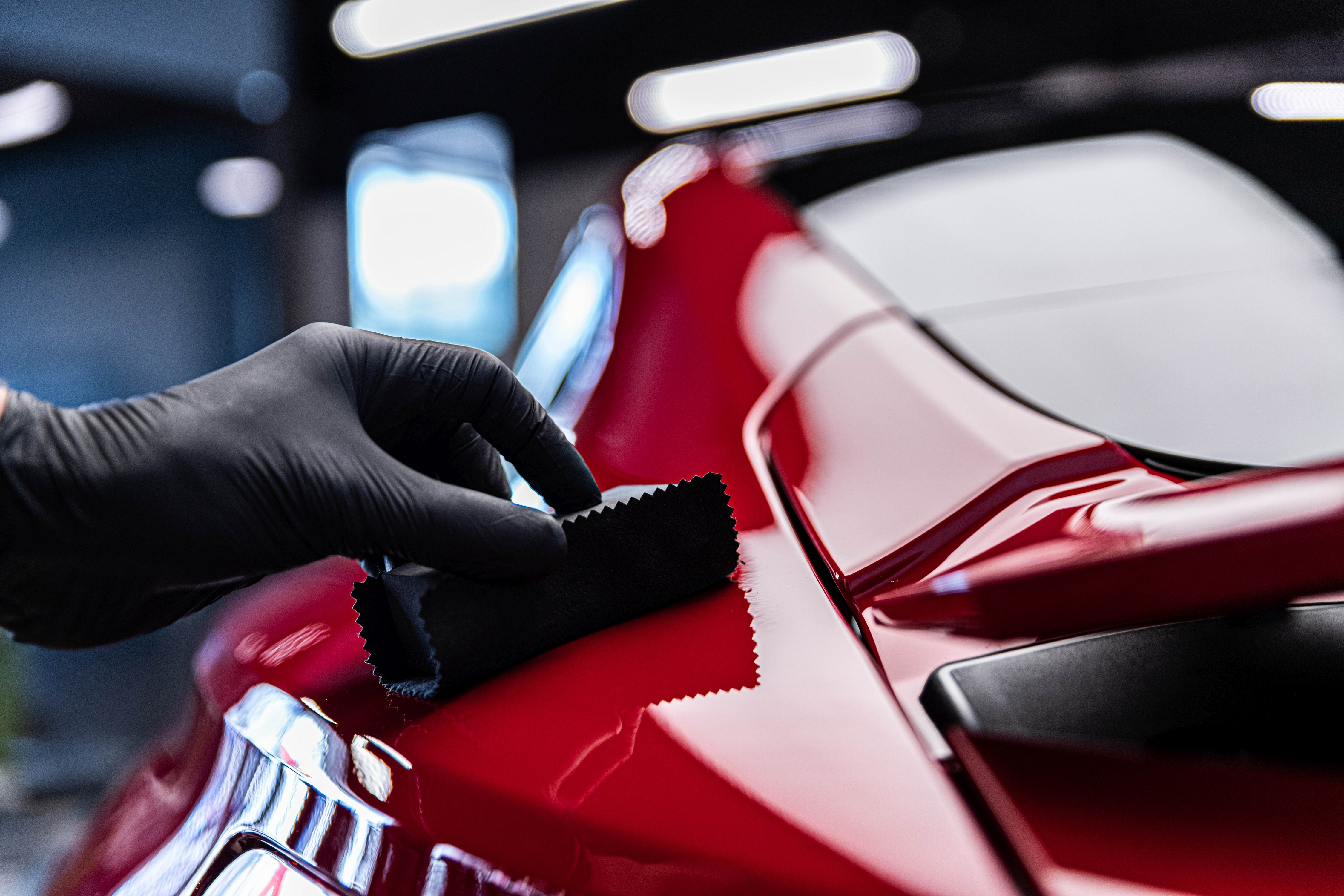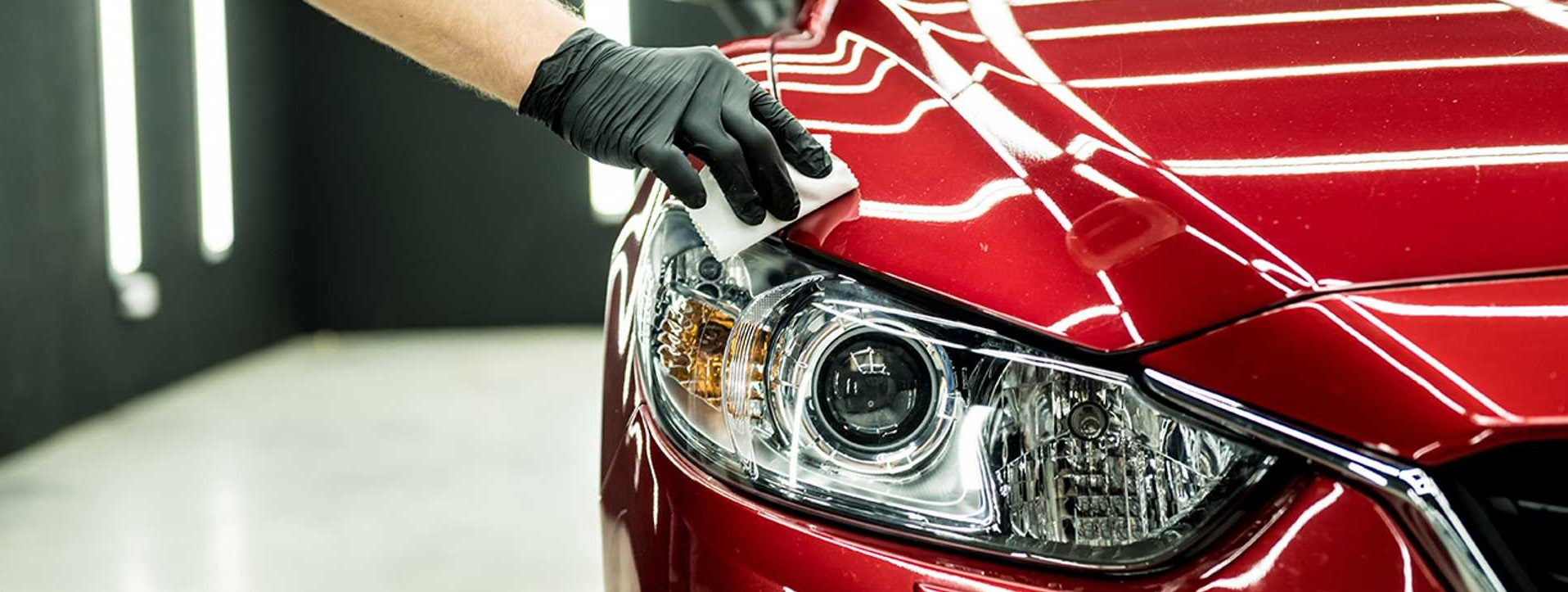Exploring the Scientific Research Behind Car Ceramic Coating and Its Safety Properties
The science of car ceramic coating offers a fascinating study in sophisticated automobile protection. Composed mainly of silicon dioxide and polymers, these finishings form a robust bond with lorry paint. This interaction boosts resilience against environmental risks while supplying hydrophobic advantages. The ins and outs of exactly how these layers work and their long-term benefits continue to be much less recognized. Ceramic Coating Newark. Unboxing these details reveals why ceramic coatings are coming to be a recommended selection for lorry treatment
What Is Ceramic Coating?
Ceramic coating is a fluid polymer that chemically bonds to the surface area of a lorry's paint. This sophisticated protective layer boosts toughness and uses exceptional resistance to environmental factors. Unlike typical wax or sealants, which offer short-lived security, ceramic finishings create a lasting shield that can endure severe conditions such as UV rays, acidic contaminants, and extreme weather. When used appropriately, the coating creates a hydrophobic surface, causing water to grain and slide off, which assists in preserving the automobile's sanitation. In addition, it provides enhanced gloss and deepness to the paint, making the car show up even more polished and lively. The application process generally entails complete surface preparation, consisting of cleaning and sprucing up, to guarantee peak bonding. Consequently, ceramic finishes are ending up being significantly popular amongst car lovers and those looking for to safeguard their financial investments, assuring to maintain the car's aesthetic appeal while reducing the frequency of maintenance.
The Structure of Ceramic Coatings
The elaborate formula of ceramic finishes largely contains silicon dioxide (SiO2), which is obtained from natural resources like quartz and sand. This key element gives the foundation for the coating's toughness and protective qualities. In addition to SiO2, ceramic finishings usually include different polymers and ingredients that enhance bond, versatility, and resistance to ecological elements. These compounds function synergistically to create a robust barrier against contaminants such as dust, chemicals, and UV rays.Furthermore, some solutions incorporate titanium dioxide (TiO2) or various other nanomaterials, which can augment the coating's hydrophobic properties, leading to improved water repellency. The accurate make-up can differ significantly amongst suppliers, influencing efficiency and durability. Ultimately, the mix of these components finishes in a safety layer that not only improves the aesthetic charm of lorries yet also serves to extend their life expectancy by securing the surface area from possible damages.
Just How Ceramic Coatings Job
Understanding how ceramic coverings function includes discovering their chemical structure, which adds to their protective top qualities. The application process is necessary for accomplishing excellent outcomes, while long life and longevity aspects figure out the coating's efficiency in time. With each other, these elements highlight the benefits and performance of ceramic coatings for lorry defense.
Chemical Structure Explained
While many car owners seek durable protection for their lorries, the chemical composition of ceramic finishes plays a crucial duty in their efficiency. These coatings mostly consist of silicon dioxide (SiO2), which is stemmed from all-natural minerals. This compound creates a strong bond with the automobile's paint, developing a long lasting, protective layer. In addition, numerous ceramic coverings contain titanium dioxide (TiO2), enhancing their hydrophobic residential properties and resistance to UV rays. The visibility of polysiloxanes can further boost versatility and resilience. With each other, these components contribute to the coating's capacity to ward off water, dust, and contaminants, while likewise offering a high-gloss finish. Comprehending this chemical foundation assists car proprietors value the robust protection used by ceramic layers.
Application Process Introduction
Applying ceramic finishings entails a careful procedure that guarantees excellent bonding and protection for the car's surface. Complete cleansing and purification of the car's outside are carried out to remove dust, grime, and previous waxes. This action validates that the surface area is complimentary from contaminations that could hinder adhesion. Following this, the paint is commonly brightened to enhance clarity and remove any type of flaws. Once prepared, the ceramic coating is applied in little sections utilizing an applicator pad, enabling uniform protection. The coating is then left to heal, developing a strong chemical bond with the surface. Correct healing times and conditions are vital, as they validate the coating attains its optimum effectiveness and safety high qualities.
Long Life and Resilience Aspects
Ceramic layers are created to give durable security with their innovative chemical composition, which creates a robust barrier versus environmental pollutants. The longevity of these layers is affected by his explanation elements such as the density of the application, the top quality of the product, and the conditions under which the car is exposed. Top quality ceramic coverings can last a number of years, standing up to scratches, UV rays, and chemical stains. Proper maintenance, consisting of routine washing and regular reapplication, can even more enhance long life. Furthermore, environmental aspects like environment and direct exposure to pollutants can affect the lifespan of the coating. On the whole, when applied and kept properly, ceramic layers offer remarkable durability, making them a prominent selection for car enthusiasts looking for to preserve their automobile's appearance.
Hydrophobic Features and Water Repellency
Hydrophobic properties are a trademark of high quality car ceramic finishings, considerably improving the lorry's surface area efficiency. These coverings create a molecular bond with the car's paint, leading to a surface area that repels water successfully. When water enters contact with a ceramic-coated surface area, it grains up and rolls off, lessening the quantity of fluid that remains on the paint. This habits not just adds to a visually pleasing appearance but also reduces the buildup of contaminants such as dust, crud, and roadway salts.The enhanced water repellency results in much easier cleansing and upkeep, as much less effort is required to remove unwanted compounds. Furthermore, the hydrophobic nature of ceramic coatings helps in protecting against water places, which can mar the coating of uncoated surface areas. Generally, the consolidation of hydrophobic properties in ceramic coverings plays a necessary function in preserving the vehicle's pristine appearance while simplifying maintenance.
Security Versus Scratches and UV Damage
Car ceramic finishings use substantial defense versus scratches and UV damage. The scrape resistance device produces a durable layer that absorbs influences, while the UV securing benefits assist preserve the lorry's paint stability in time. Together, these attributes contribute to a longer-lasting and visually appealing finish.
Scrape Resistance System
Using advanced modern technology, ceramic layers provide a durable guard against scratches and UV damages, enhancing the longevity and look of automobile surfaces. The scratch resistance system of these coatings is credited to their one-of-a-kind molecular structure, which develops a long lasting bond with the vehicle's paint. This bond produces a hard, protective layer that can soak up influences and resist abrasions. Furthermore, the smooth surface area of the coating lowers friction, making it difficult for impurities to adhere and trigger scratches. The chemical structure of ceramic finishings typically includes nanoparticles that reinforce the safety layer, further boosting its resilience. Lorries treated with ceramic coatings show substantially boosted scratch resistance compared to conventional wax or sealants, making sure an excellent surface over time.
UV Protecting Perks
The safety high qualities of ceramic finishes expand beyond scratch resistance to include significant UV securing advantages. These coatings create a robust obstacle that shows unsafe ultraviolet rays, guarding the lorry's paint and underlying materials. Prolonged exposure to UV radiation can bring about fading, oxidation, and damage of the paint coating. By including ceramic layers, lorry proprietors can properly alleviate these threats, protecting the aesthetic charm and stability of their vehicles. In addition, the UV obstructing residential or commercial properties contribute to enhanced longevity, minimizing the regularity of repainting and maintenance. Ultimately, the assimilation of ceramic finishes uses a detailed remedy for securing cars from the destructive impacts of sun direct exposure, making sure a continual, vivid appearance over time.
The Durability and Maintenance of Ceramic Coatings

Often Asked Questions
Can Ceramic Coating Be Applied to Any Sort Of Lorry?
Ceramic coating can be related to different kinds of lorries, including automobiles, vehicles, and motorbikes. Surface preparation and compatibility with particular materials are vital for optimal bond and efficiency of the coating.
How Much Does Ceramic Coating Normally Expense?
Ceramic coating usually costs in between $500 and $2,000, depending on factors such as visit this site car dimension, coating high quality, and professional application. The financial investment can give long-lasting defense and boost the automobile's appearance in time.

Is Expert Application Necessary for Best Outcomes?
The need of professional application often depends on preferred additional reading results. Specialists commonly assure correct surface area preparation and application strategies, resulting in perfect bonding and long life of the coating, which may be testing for unskilled individuals to attain.
Can Ceramic Coatings Be Removed or Fixed?
Ceramic coverings can be gotten rid of or repaired, though the procedure might call for certain solvents or techniques - Ceramic Coating Newark. Appropriate elimination is vital to avoid damage to the underlying surface area, emphasizing the importance of specialist support for ideal outcomes
How Does Porcelain Coating Contrast to Typical Wax?
The comparison in between ceramic coating and conventional wax discloses that ceramic finishes provide premium durability, enhanced protection against environmental contaminants, and longer-lasting sparkle, while wax calls for much more constant application and offers much less overall resistance to damage.